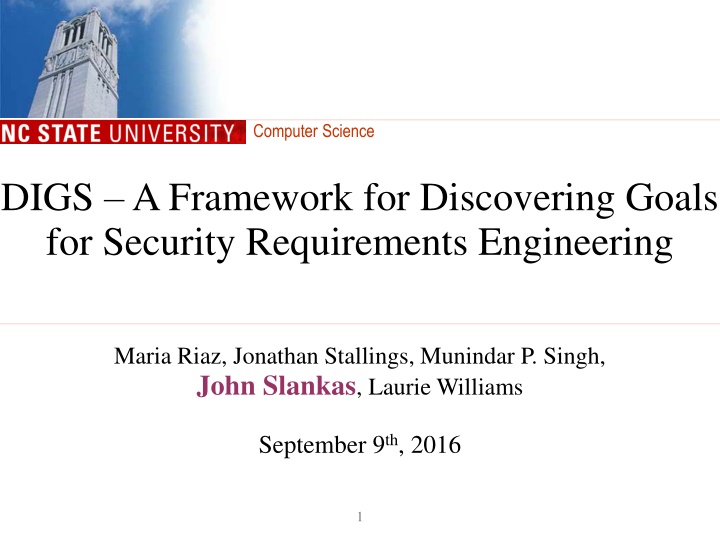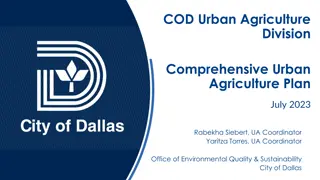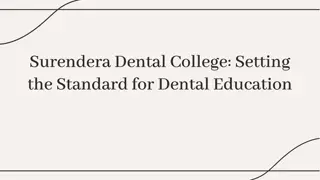
Discovering Security Goals Framework in Computer Science Research
Explore a framework for discovering security goals in requirements engineering for software systems. This research aims to integrate security considerations seamlessly with system functionality, addressing vulnerabilities and limited expertise. The DIGS framework facilitates the systematic discovery of security goals to enhance overall system security and mitigate risks effectively.
Download Presentation

Please find below an Image/Link to download the presentation.
The content on the website is provided AS IS for your information and personal use only. It may not be sold, licensed, or shared on other websites without obtaining consent from the author. If you encounter any issues during the download, it is possible that the publisher has removed the file from their server.
You are allowed to download the files provided on this website for personal or commercial use, subject to the condition that they are used lawfully. All files are the property of their respective owners.
The content on the website is provided AS IS for your information and personal use only. It may not be sold, licensed, or shared on other websites without obtaining consent from the author.
E N D
Presentation Transcript
Computer Science DIGS A Framework for Discovering Goals for Security Requirements Engineering Maria Riaz, Jonathan Stallings, Munindar P. Singh, John Slankas, Laurie Williams September 9th, 2016 1
Agenda Motivation Research Objective DIGS Framework Evaluation Methodology Results On-going: Security Goals to Requirements Conclusion Computer Science 2
Motivation Integrating Security Requirements with System Functionality 92% of the vulnerabilities are in the system implementation [NVD] Limited Security Expertise and Resources [RePa12] [CWE-SANS Top 25 Vulnerabilities] Missing Security-Related Functionality https://www.sans.org/top25-software-errors/ Computer Science 3
Research Objective To requirements engineering by providing a framework that supports a systematic and comprehensivediscovery of security goals for a software system. support analysts in security Computer Science 4
DIGS Framework Computer Science
Security Goal Patterns: DIGSFramework Security Actions Security Properties Prevent of <asset> a breach of Detect [when <actor> <performs action>] Respond to Security Goal Pattern: <prevent | detect | respond to>a breach of <Security Property>of <asset> [when <actor> <performs action>] Computer Science 7
Initial and Implied Goals: DIGS Framework Implied Goal(s) Initial Goal(s) preventa breach of Confidentialityof discharge instructions ID & Authentication of actors Availability of access enforcement mechanisms detecta breach of Integrityof discharge instructions Accountability of actions Integrity of audit records Computer Science 8
Security Goals Identification: Experiment Design Post-Task Survey Pre-Task Quiz Main Task Assess relevant knowledge Create balanced groups Demographics Feedback about task Identify security goals 28 participants [Networks Security Course] Two real-world systems: iHRIS / Cyclos [High level features, assets in the system] Split-plot design: Treatment [Analyze Both Systems] + Control [Analyze Both Systems] 18 Security Goal Patterns + Implied Goals, Systematic Process Cyclos Cyclos Cyclos iHRIS iHRIS iHRIS iHRIS Cyclos Cyclos Cyclos iHRIS iHRIS Control Treatment Computer Science 9
Security Goals Identification: Empirical Evaluation: Hypothesis and Metrics Research Question: Can analysts identify the implied security goals without explicit knowledge? H02: Explicit knowledge about implied security goals does not impact their identification Metrics: Precision of overall goals w.r.t oracle Recall of overall goals w.r.t oracle Recall of implied goals w.r.t oracle Computer Science 10
Security Goals Identification: Results Recall based on Implied Goals Precision and Recall Computer Science 11
Security Goals Identification: Results Combined Goals Identified by Group iHRIS Cyclos Goals O (#) C (%) T (%) O (#) C (%) T (%) Initial 71 82% 92% 36 94% 97% Implied 37 24% 54% 25 12% 40% Total 108 62% 79% 61 61% 74% O: Oracle; C: Control ; T: Treatment; Computer Science 12
Identifying Security Goals: Types of Goals Identified by Participants C C PR PR I I AY AY A A ID ID Computer Science 13
From Security Goals to Requirements : Security Requirements Patterns from NIST Controls Pattern Name: R-AY-1: Respond to failures in accountability. Problem (Security Goal): <respond to> a breach of <Accountability> of user actions. Context: An attacker may compromise the mechanisms for accountability to covertly perform malicious activity in the system OR the mechanism may fail arbitrarily. o ... Solution (Security Requirements Templates): The system shall: a) respond to audit processing failures by alerting <authorized user>. b) have provision for alternate audit capability to record <designated actions> if the primary audit capability fails. Source (NIST Controls): AU-5, AU-15. See Also: P-ALL-1: Enable continuous monitoring, D-ALL-1: Monitoring for security incidents, 35 security requirements patterns [20 prevention, 7 detection, 8 response] Computer Science 14
Conclusion Considerations for Future Studies Control group without knowledge of 18 goal patterns. Individuals may prioritize security goals differently. Systematic process may lead to positive task experience. Research Directions Automatically construct goals from functional requirements through natural language processing Map the goals to later software development phases (design / testing) Computer Science 15
References [Alexander03] Alexander, Ian. Misuse Cases: Use Cases with Hostile Intent. IEEE Software 20 (1): 58 66. 2003 [Ali09] Ali, Raian, Fabiano Dalpiaz, and Paolo Giorgini. A Goal Modeling Framework for Self-Contextualizable Software. Lecture Notes in Business Information Processing 29 LNBIP: 326 38. 2009 [Asnar07] Asnar, Yudistira, Paolo Giorgini, Fabio Massacci, and Nicola Zannone. From Trust to Dependability through Risk Analysis. Proceedings - Second International Conference on Availability, Reliability and Security, ARES 2007, 19 26. [Daramalo12] Daramola, Olawande, Guttorm Sindre, and Tor Stalhane. Pattern-Based Security Requirements Specification Using Ontologies and Boilerplates. 2nd IEEE International Workshop on Requirements Patterns, RePa 2012 - Proceedings, 54 59. 2012 [Haley08] Haley, Charles B, Robin Laney, Jonathan D Moffett, and Bashar Nuseibeh. 2008. Security Requirements Engineering: A Framework for Representation and Analysis. IEEE Transactions on Software Engineering 34 (1): 133 53 [Massacci10] Massacci, Fabio, John Mylopoulos, and Nicola Zannone. Security Requirements Engineering: The SI* Modeling Language and the Secure Tropos Methodology. Advances in Intelligent Information Systems 265: 147 74. 2010 [McGraw06] G. McGraw. Software Security: Building Security In , Addison Wesley Professional, 2006. [NVD] Alshazly, A.A., Elfatatry, A.M. and Abougabal, M.S. 2014. Detecting defects in software requirements specification. Alexandria Engineering Journal. 53, 3 (2014), 513 527. [Schneider12] Kurt Schneider, Eric Knauss, Siv Houmb, Shareeful Islam, and J. J rjens, "Enhancing security requirements engineering by organizational learning," Requirements Engineering, vol. 17, pp. 35-56, 2012. [Schumacher06] M. Schumacher, E. Fernandez-Buglioni, D. Hyberston, F. Buschmann, and P. Sommerlad, Security Patterns: Integrating Security and Systems Engineering. West Sussex: John Wiley & Sons, Ltd, 2006. [Sindre05] Sindre, G, and A L Opdahl. Eliciting Security Requirements with Misuse Cases. Requirements Engineering 10 (1) . 2005 [Slankas13] J. Slankas and L. Williams, "Access Control Policy Extraction from Unconstrained Natural Language Text", 2013 ASE/IEEE International Conference on Privacy, Security, Risk, and Trust (PASSAT), Washington D.C., USA, September 8-14, 2013. [Slankas14] Slankas, J, X Xiao, L Williams, and T Xie. Relation Extraction for Inferring Access Control Rules from Natural Language Artifacts. Annual Computer Security Applications Conference (ACSAC 2014). New Orleans, LA. 2014 [Souag15] Souag, Amina, Ra l Mazo, Camille Salinesi, and Isabelle Comyn-Wattiau. Reusable Knowledge in Security Requirements Engineering: A Systematic Mapping Study. Requirements Engineering, 251 83. 2015 [Square05] N. R. Mead, E. D. Houg, and T. R. Stehney, "Security Quality Requirements Engineering (SQUARE) Methodology," Software Engineering Inst., Carnegie Mellon University2005. Computer Science 16
References [CyberSec 2016] Hibshi, Hanan, Travis Breaux, Maria Riaz, and Laurie Williams. A Grounded Analysis of Experts Decision-Making During Security Assessments. Submitted to: Journal of CyberSecurity, Feb 2016. [ESEM 2014] Riaz, Maria, John Slankas, Jason King, and Laurie Williams. 2014. Using Templates to Elicit Implied Security Requirements from Functional Requirements - A Controlled Experiment. In 8th ACM/IEEE International Symposium on Empirical Software Engineering and Measurement (ESEM), 1 10. Torino [ESEM 2016] Riaz, Maria, Jonathan Stallings, Munindar P. Singh, John Slankas, and Laurie Williams. 2016. DIGS A Framework for Discovering Goals for Security Requirements Engineering. In Empirical Software Engineering and Measurement (ESEM) (to Appear). Ciudad Real [ESE Journal 2016] Riaz, Maria, Jason King, John Slankas, Laurie Williams, Fabio Massacci, Christian Quesada Lopez, and Marcelo Jenkins. Identifying the implied: Findings from Three Differeniated Replications on the Use of Security Requirements Templates . Empirical Software Engineering Journal, 1st Submission: Nov. 2015. Revision: May 2016. [ESE Journal 2016] King, Jason, John Stallings, Maria Riaz, and Laurie Williams. To Log, or Not To Log: Using Heuristics to Identify Mandatory Log Events A Controlled Experiment . Empirical Software Engineering Journal, 1st Submission: Oct. 2015. Revision: April 2016. [ICSE 2016] Industrial case study with Cisco To Submit [IST Journal 2015] Riaz, Maria, Travis Breaux, and Laurie Williams. 2015. How Have We Evaluated Software Pattern Application? A Systematic Mapping Study of Research Design Practices. Information and Software Technology 65: 14 38. doi:10.1016/j.infsof.2015.04.002 [RE 2014] Riaz, Maria, Jason King, John Slankas, and Laurie Williams. 2014. Hidden in Plain Sight: Automatically Identifying Security Requirements from Natural Language Artifacts. In 22nd International Requirements Engineering Conference (RE), 183 92. Karlskrona: IEEE [RE-ESPRE 2014] Hibshi, Hanan, Travis Breaux, Maria Riaz, and Laurie Williams. 2014. Towards a Framework to Measure Security Expertise in Requirements Analysis. In 1st International Workshop on Evolving Security and Privacy Requirements Engineering (ESPRE), 13 18. Sweden [RE-ESPRE 2016] Riaz, Maria, Sarah Elder, and Laurie Williams. 2016. Systematically Developing Prevention, Detection and Response Patterns for Security Requirements . Submitted to: 3rd International Workshop on Evolving Security and Privacy Requirements Engineering (ESPRE). Beijing. [RE Journal 2012] Jeremy C. Maxwell, Annie I. Anton, Peter Swire, Maria Riaz, Christopher M. McCraw. "A Legal Cross-References Taxonomy for Reasoning About Compliance," Requirements Engineering Journal, 17(2), pp 99-115, Springer-Verlag, 2012 [RePa 2012] Riaz, Maria, and Laurie Williams. 2012. Security Requirements Patterns: Understanding the Science behind the Art of Pattern Writing. In Proceedings of the 2nd IEEE International Workshop on Requirements Patterns (RePa), 29 34. Chicago Computer Science 17
Backup Slides BACKUP Computer Science 18
Security Properties Definitions The degree to which the "data is disclosed only as intended [SECPAT] Confidentiality (C) The degree to which a system or component prevents unauthorized access to, or modification of, computer programs or data. [IEEE] "The degree to which a system or component is operational and accessible when required for use." [IEEE] Integrity (I) Availability (A) Identification & Authentication (IA) The need to establish that "a claimed identity is valid" for a user, process or device. [NIST-SP800-33] Degree to which actions affecting software assets "can be traced to the actor responsible for the action [SECPAT] Accountability (AY) The degree to which an actor can understand and control how their information is used. [RE14] Privacy (PR) Computer Science 19
Security Properties Classifying Security Goals and Requirements classifying sentences in requirements artifacts cataloging security requirements patterns Spoofing Tampering Repudiation Information Disclosure Denial of Service Elevation of Privileges Computer Science 20
Additional Information Precision, Recall, F1 Measure Precision (P) is the proportion of correctly predicted classifications for security properties in the input sentences: ? = ??/(?? + ??). Recall (R) is the proportion of sentences found for a security property: ? = ??/(?? + ??) F1 Measure is the harmonic mean between P and R: F1= 2 ? ? /(? + ?) True Positive (TP): identified by participant -- in the oracle False Positive (FP): identified by participant -- not in the oracle True Negative (TN): not identified by participant -- not in the oracle False Negative (FN): not identified by the participant -- in the oracle Expected Classification No True Positive False Negative Yes Predicted Classification Yes False Negative True Negative No Computer Science 21
Additional Information Inter-rater Agreement (Fleiss Kappa) How well do multiple raters agree beyond what s possible by chance? ? ?? ? = 1 ?? Degree of agreement attained above chance divided by the degree of agreement possible above chance Fleiss Kappa <= 0 0.01 0.20 0.21 0.40 0.41 0.60 0.61 0.80 0.81 0.99 Agreement Interpretation Less than chance Slight Fair Moderate Substantial Almost perfect Computer Science 22
Steps for applying DIGS Computer Science
Example: Initial Security Goals Computer Science
Example: Implied Security Goals Computer Science
Security Goals & Requirements Security Goals: security-related outcomes a system must ensure or prevent [Firesmith03] Security requirements: security-related functionality/behavior or properties/quality attributes or constraints [MARTIN07, SOAR07, CIGITAL] Security Goals Why? have operationalize context What? Software Systems Security Requirements [Lamsweerde03] Computer Science 26
Implied Security Goals Computer Science











